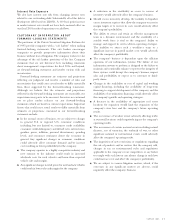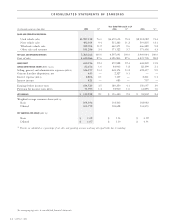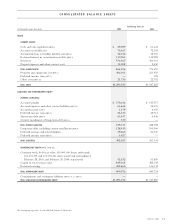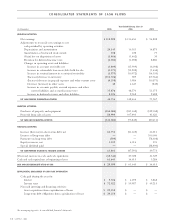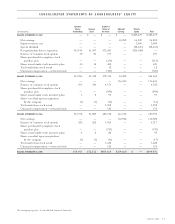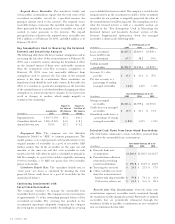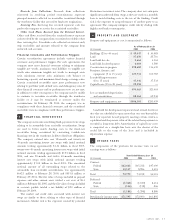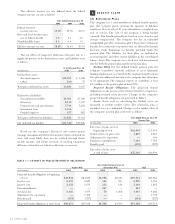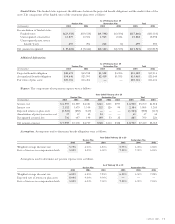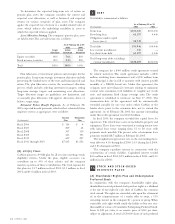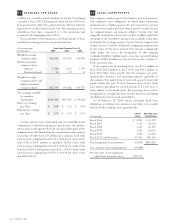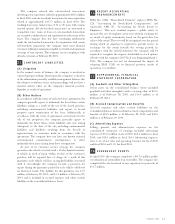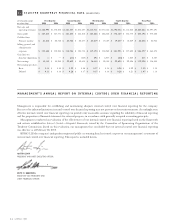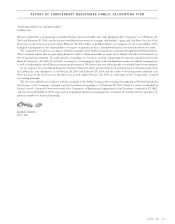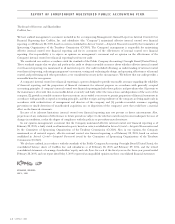CarMax 2005 Annual Report Download - page 39
Download and view the complete annual report
Please find page 39 of the 2005 CarMax annual report below. You can navigate through the pages in the report by either clicking on the pages listed below, or by using the keyword search tool below to find specific information within the annual report.
CARMAX 2005
37
Proceeds from Collections. Proceeds from collections
reinvested in revolving period securitizations represent
principal amounts collected on receivables securitized through
the warehouse facility that are used to fund new originations.
Servicing Fees. Servicing fees received represent cash fees
paid to the company to service the securitized receivables.
Other Cash Flows Received from the Retained Interest.
Other cash flows received from the retained interest represent
cash received by the company from securitized receivables other
than servicing fees. It includes cash collected on interest-only
strip receivables and amounts released to the company from
restricted cash accounts.
Financial Covenants and Performance Triggers
Certain securitization agreements include various financial
covenants and performance triggers. For such agreements, the
company must meet financial covenants relating to minimum
tangible net worth, maximum total liabilities to tangible net
worth ratio, minimum tangible net worth to managed assets
ratio, minimum current ratio, minimum cash balance or
borrowing capacity, and minimum fixed charge coverage ratio.
Certain securitized receivables must meet performance tests
relating to portfolio yield, default rates, and delinquency rates. If
these financial covenants and/or performance tests are not met,
in addition to other consequences, the company may be unable
to continue to securitize receivables through the warehouse
facility or it may be terminated as servicer under the
securitizations. At February 28, 2005, the company was in
compliance with these financial covenants, and the securitized
receivables were in compliance with these performance triggers.
FINANCIAL DERIVATIVES
The company enters into amortizing fixed-pay interest rate swaps
relating to its automobile loan receivable securitizations. Swaps
are used to better match funding costs to the fixed-rate
receivables being securitized by converting variable-rate
financing costs in the warehouse facility to fixed-rate obligations.
The company entered into one 18-month and twenty-six
40-month amortizing interest rate swaps with initial notional
amounts totaling approximately $1.36 billion in fiscal 2005,
twenty-two 40-month amortizing interest rate swaps with initial
notional amounts totaling approximately $1.21 billion in fiscal
2004, and one 20-month and twelve 40-month amortizing
interest rate swaps with initial notional amounts totaling
approximately $1.05 billion in fiscal 2003. The amortized
notional amount of all outstanding swaps related to the
automobile loan receivable securitizations was approximately
$662.1 million at February 28, 2005, and $551.8 million at
February 29, 2004. The fair value of swaps included in prepaid
expenses and other current assets totaled a net asset of $5.4
million at February 28, 2005, and the fair value of swaps included
in accounts payable totaled a net liability of $2.0 million at
February 29, 2004.
The market and credit risks associated with interest rate
swaps are similar to those relating to other types of financial
instruments. Market risk is the exposure created by potential
fluctuations in interest rates.The company does not anticipate
significant market risk from swaps as they are used on a monthly
basis to match funding costs to the use of the funding. Credit
risk is the exposure to nonperformance of another party to an
agreement.The company mitigates credit risk by dealing with
highly rated bank counterparties.
PROPERTY AND EQUIPMENT
Property and equipment, at cost, is summarized as follows:
As of February 28 or 29
(In thousands) 2005 2004
Buildings (25 to 40 years) $ 49,047 $ 30,985
Land 37,650 25,716
Land held for sale 2,664 3,163
Land held for development 6,084 3,580
Construction in progress 198,682 116,639
Furniture, fixtures, and
equipment (5 to 15 years) 125,734 103,787
Leasehold improvements
(8 to 15 years) 45,346 37,533
Capital leases (15 to 20 years) 29,258 —
494,465 321,403
Less accumulated depreciation
and amortization 88,164 69,944
Property and equipment, net $406,301 $251,459
Land held for development represents land owned for future
sites that are scheduled to open more than one year beyond the
fiscal year reported. Leased property meeting certain criteria is
capitalized and the present value of the related lease payments is
recorded as long-term debt. Amortization of capital lease assets
is computed on a straight-line basis over the shorter of the
useful life or the term of the lease and is included in
depreciation expense.
INCOME TAXES
The components of the provision for income taxes on net
earnings were as follows:
Years Ended February 28 or 29
(In thousands) 2005 2004 2003
Current:
Federal $62,662 $65,212 $47,600
State 10,117 8,986 5,415
Total 72,779 74,198 53,015
Deferred:
Federal (1,068) (1,180) 8,614
State (116) (118) 266
Total (1,184) (1,298) 8,880
Provision for income taxes $71,595 $72,900 $61,895
5
6
7


